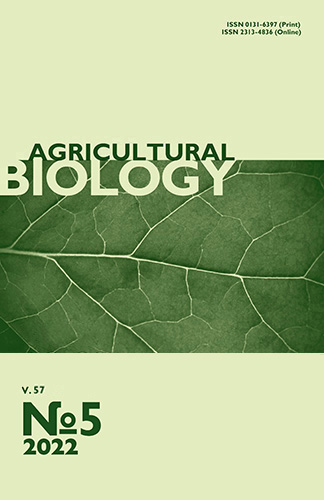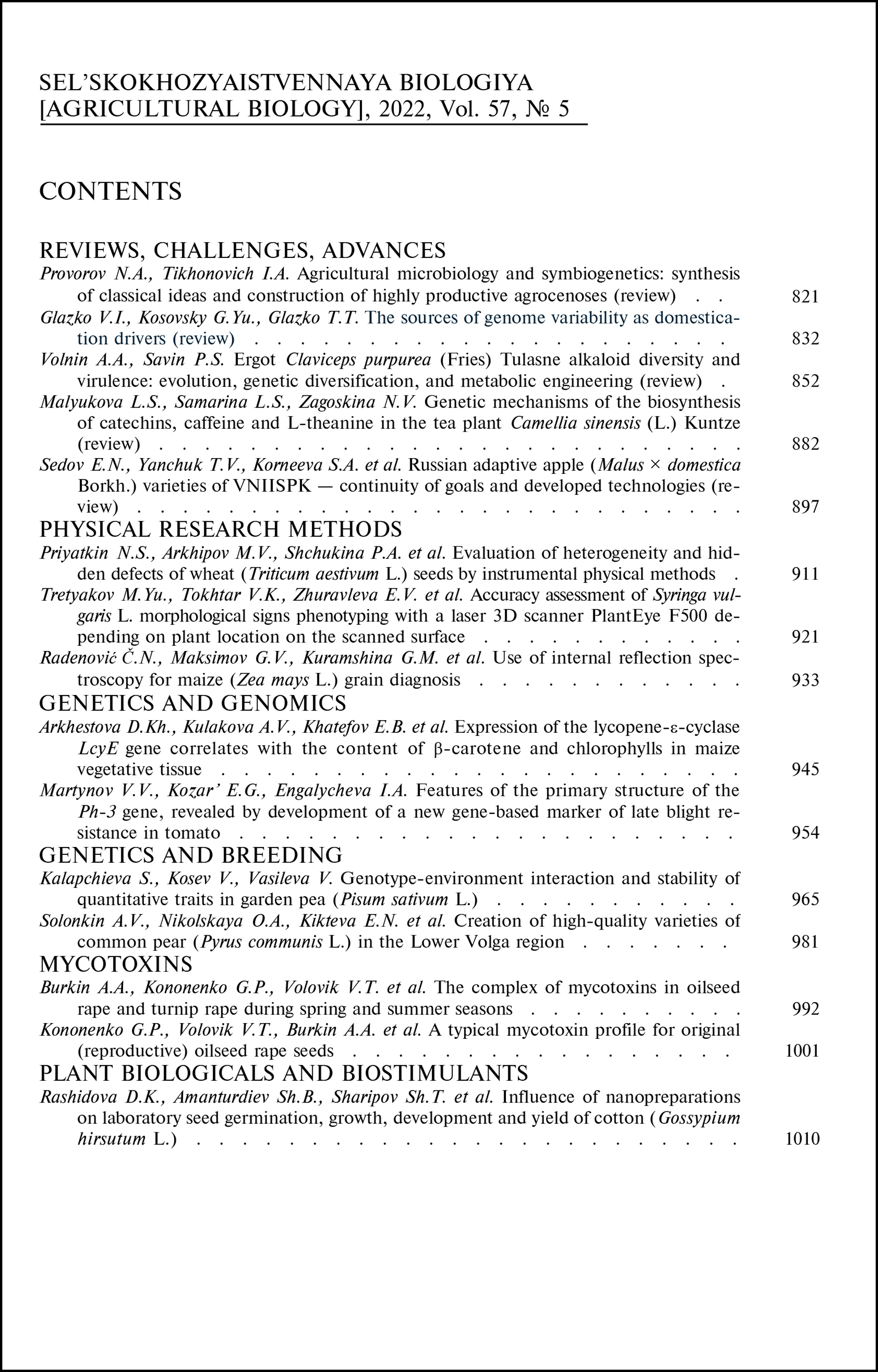doi: 10.15389/agrobiology.2022.5.945eng
UDC:633.15:577.2
Acknowledgements:
Supported financially by the Federal Scientific and Technical Program for the Development of Agriculture of the Russian Federation (subprogram “Agrarian Science — a Step into the Future Development of the Agro-Industrial Complex”).
EXPRESSION OF THE LYCOPENE-ε-CYCLASE LcyE GENE
CORRELATES WITH THE CONTENT OF β-CAROTENE
AND CHLOROPHYLLS IN MAIZE VEGETATIVE TISSUE
D.Kh. Arkhestova1, 2, A.V. Kulakova1 ✉, E.B. Khatefov3,
A.V. Shchennikova1, E.Z. Kochieva1
1Federal Research Centre Fundamentals of Biotechnology RAS, 33/2, Leninsky prospect, Moscow, 119071 Russia, e-mail Khavpacheva.dzhenet@mail.ru, kulakova_97@mail.ru (✉ corresponding author), shchennikova@yandex.ru,
ekochieva@yandex.ru;
2Institute of Agriculture, Federal Kabardino-Balkarian Scientific Center RAS, 224/21A, ul. Kirova, Nalchik, Kabardino-Balkarian Republic, 360004 Russia;
3Federal Research Center Vavilov All-Russian Institute of Plant Genetic Resources, 42-44, ul. Bol’shaya Morskaya, St. Petersburg, 190000 Russia, e-mail haed1967@rambler.ru
ORCID:
Arkhestova D.Kh. orcid.org/0000-0003-1239-3641
Shchennikova A.V. orcid.org/00000000-0003-4692-3727
Kulakova A.V. orcid.org/00000000-0002-3124-525X
Kochieva E.Z. orcid.org/00000000-0002-6091-0765
Khatefov E.B. orcid.org/00000000-0001-5713-2328
Received July 15, 2022
Maize (Zea mays L.) is an important world crop. One of the valuable traits of this plant is the biosynthesis of vitamin A precursors in kernel (dietary nutrition) and photosynthetic tissue (protection of the plant from stress; silage with increased dietary value). The amount of synthesized provitamin A in kernel depends on the level of expression of the lycopene-ε-cyclase LcyE gene, which catalyzes the formation of α-carotene and is involved in the regulation of the ratio of b-b and b-e fluxes of carotenoid metabolism. The aim of the study was to analyze the correlation between the content of the sum of carotenoids, β-carotene, and chlorophylls a and b with the expression of the LcyE gene in the leaves of inbred maize lines of domestic selection. To achieve the goal, four inbred maize lines were used in the study: three white-grained (6097-1, MBK and Shumny's Tetraploid) and one (5580-1) with yellow grain color. Expression of the LcyE gene in leaves was determined by quantitative real-time PCR. Quantitative determination of the amount of carotenoids, chlorophylls a and b, and β-carotene in leaves was carried out spectrophotometrically using the Folch method. Correlations between pigment content and LcyE gene expression were evaluated using statistical methods. As a result, we assessed a possible correlation between the activity of the LcyE gene and the content of carotenoids and chlorophylls in the photosynthetic tissue of four maize lines: three white-grained (6097-1, MBC and Shumnoy Tetraploid) and one (5580-1) with yellow-colored kernel. Quantification of carotenoids revealed the highest content of these pigments in the leaves of the Tetraploid Shumny line. The accessions of the remaining three lines synthesized a smaller amount of carotenoids and were similar to each other in this parameter. At the same time, β-carotene, as well as chlorophylls a and b, were most of all contained in the leaves of line 6097-1 — approximately 2 times more than in other analyzed lines, where the pigment content did not differ significantly. Thus, the absence of associations between the color of the kernel and the content of the b-carotene and sum of carotenoids in maize leaves was confirmed. On the other hand, the obtained data suggest a positive relationship between the amount of β-carotene and chlorophylls (a and b). It is possible to assume an increased rate of photosynthesis in the photosynthetic tissues of line 6097-1 in comparison with other analyzed maize lines. Accordingly, line 6097-1 may have an increased resistance to oxidative stress, as well as be a donor of a trait with an increased content of provitamin A (as a silage crop). The expression of the lycopene-ε-cyclase LycE gene was determined in the same leaf tissues. It was shown that the LycE gene was expressed ~ 4-5 times higher in the leaves of accessions of lines 5580-1 and Tetraploid Shumny than in the leaves of accessions of lines MBK and 6097-1. Correlation analysis showed an inverse relationship between the content of β-carotene and chlorophylls (a and b) and the level of LycE gene expression. Thus, in this study, for the first time, we assessed a possible correlation between the activity of the LcyE gene and the content of carotenoids and chlorophylls in the photosynthetic tissue of white and yellow grain maize lines of domestic selection. No associations were found between grain color and the content of total carotenoids and β-carotene in maize leaves. A positive relationship was found between the amount of β-carotene and chlorophylls a and b. For the first time, an inverse relationship between the content of β-carotene and chlorophylls a and b and the level of LycE gene expression was determined. The possibility of using data on the expression of the LycE gene in the leaf as an expression molecular marker of the amount of provitamin A synthesized in the leaves, as well as the degree of plant resistance to photooxidative stress, was demonstrated. The data obtained can be used in maize breeding to search for donors of the trait of increased content of provitamin A in the leaves.
Keywords: Zea mays L., maize, lycopene-ε-cyclase, LycE, carotenoids, chlorophylls, gene expression.
REFERENCES
- Maoka T. Carotenoids as natural functional pigments. Journal of Natural Medicines, 2020, 74(1): 1-16 CrossRef
- Baroli I., Niyogi K.K. Molecular genetics of xanthophyll-dependent photoprotection in green algae and plants. Philosophical Transactions of The Royal Society B Biological Sciences, 2000, 355(1402): 1385-1394 CrossRef
- Jahns P., Holzwarth A.R. The role of the xanthophyll cycle and of lutein in photoprotection of photosystem II. Biochimica et Biophysica Acta (BBA) - Bioenergetics, 2012, 1817(1): 182-193 CrossRef
- Ladygin V.G. Biologicheskie membrany, 2008, 25(3): 163-172 (in Russ.).
- Cunningham F.X. Jr, Pogson B., Sun Z., McDonald K.A., DellaPenna D., Gantt E. Functional analysis of the β and e lycopene cyclase enzymes of Arabidopsis reveals a mechanism for control of cyclic carotenoid formation. Plant Cell, 1996, 8: 1613-1626 CrossRef
- Rosas-Saavedra C., Stange C. Biosynthesis of carotenoids in plants: enzymes and color. In: Carotenoids in nature. Subcellular biochemistry, vol. 79. C. Stange (ed.). Springer, Cham, 2016: 35-69 CrossRef
- Wong J.C., Lambert R.J., Wurtzel E.T., Rocheford T.R. QTL and candidate genes phytoene synthase and zeta-carotene desaturase associated with the accumulation of carotenoids in maize. Theoretical and Applied Genetics, 2004, 108(2): 349-359 CrossRef
- Krinsky N.I., Johnson E.J. Carotenoid actions and their relation to health and disease. Molecular Aspects of Medicine, 2005, 26(6): 459-516 CrossRef
- Nagao A., Olson J.A. Enzymatic formation of 9-cis, 13-cis, and all-trans retinals from isomers of beta-carotene. The FASEB Journal, 1994, 8(12): 968-973 CrossRef
- Cabiddu A., Delgadillo-Puga C., Decandia M., Molle A.G. Extensive ruminant production systems and milk quality with emphasis on unsaturated fatty acids, volatile compounds, antioxidant protection degree and phenol content. Animals, 2019, 9(10): 771 CrossRef
- Graulet B., Cirié C., Martin B. Contrasted effects of dietary extruded linseed supplementation on carotenoid and liposoluble vitamin status in lactating Holstein or Montbéliarde cows fed hay or corn silage. Journal of Dairy Science, 2019, 102(7): 6210-6225 CrossRef
- Mitani T., Kobayashi K., Ueda K., Kondo S. Regional differences in the fatty acid composition, and vitamin and carotenoid concentrations in farm bulk milk in Hokkaido, Japan. Journal of Animal Science, 2021, 92(1): e13570 CrossRef
- Harjes C.E., Rocheford T.R., Bai L., Brutnell T.P., Kandianis C.B., Sowinski S.G., Stapleton A.E., Vallabhaneni R., Williams M., Wurtzel E.T., Yan J., Buckler E.S. Natural genetic variation in lycopene epsilon cyclase tapped for maize biofortification. Science, 2008, 319(5861): 330-333 CrossRef
- Yadav O.P., Hossain F., Karjagi C.G., Kumar B., Zaidi P.H., Jat S.L., Chawla J.S., Kaul J., Hooda K.S., Kumar P., Yadava P., Dhillon B.S. Genetic improvement of maize in India: retrospect and prospects. Agricultural Research, 2015, 4(4): 325-338 CrossRef
- Zunjare R.U., Chhabra R., Hossain F., Baveja A., Muthusamy V., Gupta H.S. Molecular characterization of 5' UTR of the lycopene epsilon cyclase (lcyE) gene among exotic and indigenous inbreds for its utilization in maize biofortification. 3 Biotech, 2018, 8(1): 75 CrossRef
- Li F., Vallabhaneni R., Yu J., Rocheford T., Wurtzel E.T. The maize phytoene synthase gene family: overlapping roles for carotenogenesis in endosperm, photomorphogenesis, and thermal stress tolerance. Plant Physiology, 2008, 147(3): 1334-1346 CrossRef
- Bai L., Kim E.-H., DellaPenna D., Brutnell T.P. Novel lycopene epsilon cyclase activities in maize revealed through perturbation of carotenoid biosynthesis. Plant Journal, 2009, 59(4): 588-599 CrossRef
- Luo H., He W., Li D., Bao Y., Riaz A., Xiao Y., Song J., Liu C. Effect of methyl jasmonate on carotenoids biosynthesis in germinated maize kernels. Food Chemistry, 2020, 307: 125525 CrossRef
- He W., Wang Y., Dai Z., Liu C., Xiao Y., Wei Q., Song J., Li D. Effect of UV-B radiation and a supplement of CaCl2 on carotenoid biosynthesis in germinated corn kernels. Food Chemistry, 2019, 278: 509-514 CrossRef
- Zunjare R.U., Hossain F., Muthusamy V., Baveja A., Chauhan H.S., Bhat J.S., Thirunavukkarasu N., Saha S., Gupta H.S. Development of biofortified maize hybrids through marker-assisted stacking of β-carotene hydroxylase, lycopene-e-cyclase and opaque2 genes. Frontiers in Plant Sciences, 2018, 9: 178 CrossRef
- Baveja A., Muthusamy V., Panda K.K., Zunjare R.U., Das A.K., Chhabra R., Mishra S.J., Mehta B.K., Saha S., Hossain F. Development of multinutrient-rich biofortified sweet corn hybrids through genomics-assisted selection of shrunken2, opaque2, lcyE and crtRB1 genes. Journal of Applied Genetics, 2021, 62(3): 419-429 CrossRef
- Babu R., Rojas N.P., Gao S., Yan J., Pixley K. Validation of the effects of molecular marker polymorphisms in LcyE and CrtRB1 on provitamin A concentrations for 26 tropical maize populations. Theoretical and Applied Genetics, 2013, 126(2): 389-399 CrossRef
- Pogson B.J., Rissler H.M. Genetic manipulation of carotenoid biosynthesis and photoprotection. Philosophical Transactions of The Royal Society B Biological Sciences, 2000, 355(1402): 1395-1403 CrossRef
- Lichtenthaler H.K., Buschmann C. Chlorophylls and carotenoids: measurement and characterization by UV-VIS spectroscopy. Current Protocols in Food Analytical Chemistry, 2001: F4.3.1-F4.3.8 CrossRef
- Efremov G.I., Slugina M.A., Shchennikova A.V., Kochieva E.Z. Dierential regulation of phytoene synthase PSY1 during fruit carotenogenesis in cultivated and wild tomato species (Solanum section Lycopersicon). Plants, 2020, 9(9): 1169 CrossRef
- Filyushin M.A., Dzhos E.A., Shchennikova A.V., Kochieva E.Z. Fiziologiya rasteniy, 2020, 67(6): 644 CrossRef (in Russ.).
- Owens B.F., Mathew D., Diepenbrock C.H., Tiede T., Wu D., Mateos-Hernandez M., Gore M.A., Rocheford T. Genome-wide association study and pathway-level analysis of kernel color in maize. G3 Genes|Genomes|Genetics, 2019, 9(6): 1945-1955 CrossRef
- Mehta B.K., Chhabra R., Muthusamy V., Zunjare R.U., Baveja A., Chauhan H.S., Prakash N.R., Chalam V.C., Singh A.K., Hossain F. Expression analysis of β-carotene hydroxylase1 and opaque2 genes governing accumulation of provitamin-A, lysine and tryptophan during kernel development in biofortified sweet corn. 3 Biotech, 2021, 11(7): 325 CrossRef












